Official Name:
Innisfree gets its name from the town closest to the place where it was discovered.
Location:
13 kilometres northeast of Innisfree, Alberta, Canada.
Fall or Find:
This was a fall that was observed by witnesses, as well as by an entire network of cameras!
Date:
5 February 1977, 7:17 p.m., local time.
Mass Recovered:
4.58 kilograms
Number of Fragments:
Nine fragments, with weights varying from 3.3 grams to 2.07 kilograms, were found. It is believed that all fragments have been recovered.
Strewn field:
The fragments were discovered within a small area measuring only 400 by 500 metres. This dense concentration of fragments was caused by the meteoroid's steep angle of entry when it came into the atmosphere.
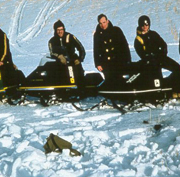
Enlargement
The research team crisscrossed the predicted impact area on snowmobiles. It took four hours to find the first fragment. |
|
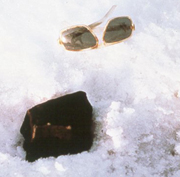
Enlargement
The main mass of the Innisfree meteorite when it was recovered. |
|
Crater:
Snow covered the farmland when the fall occurred. The main mass penetrated 30 centimetres of snow, hit the frozen ground, and bounced back up to the surface. No noteworthy crater was formed.
Circumstances:
Numerous witnesses reported the fall. They said that they saw one main fireball accompanied by six secondary trails of light.
What makes this fall special is that several observatories dedicated to meteorite tracking and recovery took photographs of the meteoroid as it passed through the atmosphere. Cameras detected the meteoroid when it was at an altitude of 58.8 kilometres. Fragmentation took place at an altitude of 25 kilometres. The fall area was calculated using the photographs of the meteoroid, and scientists were able to recover the meteorite fragments. A few days after the fall, the 2.07-kilogram main mass was found on the snow in the area predicted. The other fragments were discovered a few months later, after the snow had melted.
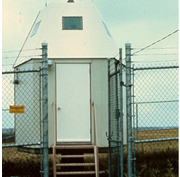
Enlargement
One of the automated observatories in the Canadian Camera Network. |
|
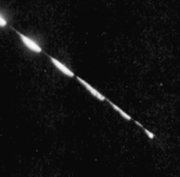
Enlargement
The Innisfree meteoroid crossing the sky. The network cameras took four photos per second, making it possible to calculate the speed of the meteoroid. |
|
History:
In 1959, a brilliant fireball was photographed by chance in Czechoslovakia. The phenomenon was captured on film by a group of cameras used to study satellite trajectories. By plotting the meteoroid's path, scientists were able to determine that its orbit passed through the asteroid belt. The location of the meteorite fragments on the ground was also estimated and fragments were found precisely at the calculated site.
Following this lucky discovery, the United States and Canada installed networks of cameras to photograph fireballs. These photographs were used to calculate where the fireballs came from, as well as their probable impact sites. The Canadian Meteorite Observation and Recovery Program (MORP) was active from 1971 to 1985. It had 12 observatories, each equipped with 5 cameras. Spread out over the southern part of the Canadian prairies, the cameras covered over 700 000 square kilometres. Innisfree is the only Canadian? meteoroid photographed for which fragments have been recovered.
Type:
Stony meteorite
Class:
Ordinary chondrite
Group:
L5
Composition:
Innisfree is composed mainly of olivine and hypersthene.
Scientific contribution:
Innisfree's orbit was very elliptical. Its farthest point from the Sun was in the asteroid belt. Its orbit crossed Earth's orbit, but did not venture much further into the inner solar system.
Innisfree is one of the rare meteorites in the world whose orbit is precisely known. Calculation of this orbit contributed to acceptance of the fact that most meteorites come from asteroids located in the belt between Mars and Jupiter.
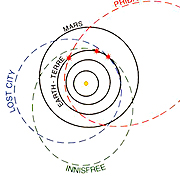
Enlargement
Diagram of the orbits of three meteorites photographed by observation networks. |
|
Comments:
By pure coincidence, the Innifree fall took place exactly 10 years (to within a few minutes) after the Vilna fall. Vilna was another meteorite that struck the Earth near Edmonton.
Part of the Planétarium's collection:
No